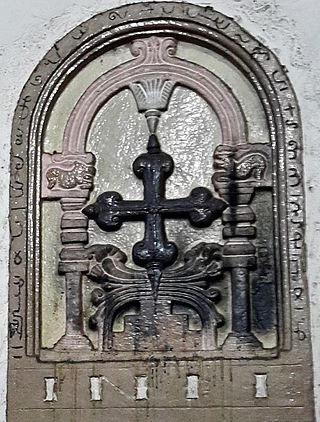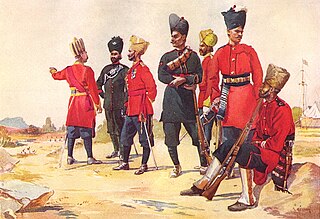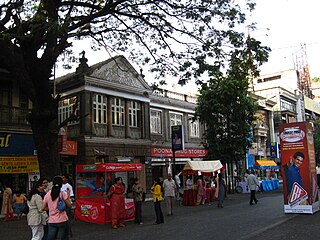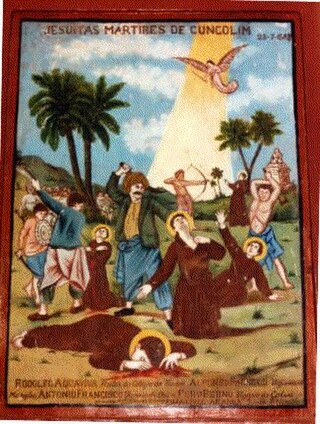
Christianity is India's third-largest religion with about 26 million adherents, making up 2.3 percent of the population as of the 2011 census. The written records of St Thomas Christians mention that Christianity was introduced to the Indian subcontinent by Thomas the Apostle, who sailed to the Malabar region in 52 AD.

The 123rd Outram's Rifles was an infantry regiment of the British Indian Army.

The East Indians, also called East Indian Catholics or Bombay East Indians, are an ethno-religious Indian Christian community native to the Seven Islands of Bombay and the neighbouring Mumbai Metropolitan Area of the Konkan division.

Pune district is a district in Western Maharashtra with Administrative Headquarters in Pune city. Pune district is the most populous district in the Indian state of Maharashtra. It is one of the most industrialised districts in India.

The Catholic Church in India is part of the worldwide Catholic Church under the leadership of the Pope. There are over 20 million Catholics in India, representing around 1.55% of the total population, and the Catholic Church is the single largest Christian church in India. There are 10,701 parishes that make up 174 dioceses and eparchies, which are organised into 29 ecclesiastical provinces. Of these, 132 dioceses are of the Latin Church, 31 of the Syro-Malabar Catholic Church and 11 of the Syro-Malankara Catholic Church. Despite the very small population that Indian Catholics make up percentage wise, India still has the second-largest Christian population in Asia after the Catholic Church in the Philippines.

The Anglo-Persian War or the Anglo-Iranian War lasted between 1 November 1856 and 4 April 1857, and was fought between the United Kingdom and Iran, which was ruled by the Qajar dynasty. The war had the British oppose an attempt by Iran to press its claim on the city of Herat. Though Herat had been part of Iran under the Qajar dynasty when the war broke out, it had declared itself independent under its own rebellious emir and placed itself under the protection of the British in India and in alliance with the Emirate of Kabul, the predecessor of the modern state of Afghanistan. The British campaign was successfully conducted under the leadership of Major General Sir James Outram in two theatres: on the southern coast of Persia near Bushehr and in southern Mesopotamia.

The Battle of Khadki, also known as or the Battle of Ganeshkhind and Battle of Kirkee took place at modern day Khadki, India, on 5 November 1817 between the forces of the British East India Company and the Maratha Empire under the leadership of Appasaheb Bhonsle. Company forces achieved a decisive victory, with Khadki later becoming a military cantonment under British rule.
Khadki is a cantonment in the city of Pune, India. It has now flourished as a quasi-metropolis & centered in the northern region of the city.

The Bombay Engineer Group, or the Bombay Sappers as they are informally known, are a regiment of the Corps of Engineers of the Indian Army. The Bombay Sappers draw their origin from the erstwhile Bombay Presidency army of the British Raj. The group has its centre in Khadki, Pune in Maharashtra state. The Bombay Sappers have gone on to win many honours and awards, both in battle and in peacetime, throughout the 19th and 20th centuries, both before and after Independence. The gallantry awards won include the British Victoria Cross and the French Legion of Honour before independence, as well as the Param Vir Chakra and Ashok Chakra as part of Independent India. The Group has also made its mark in peacetime activities such as sport, adventure, disaster relief, aid to civil authority and prestigious construction projects.
Pune is the 9th most populous city in India and one of the largest in the state of Maharashtra.

The Battle of Koregaon was fought on 1 January 1818 between the British East India Company and the Peshwa faction of the Maratha Confederacy, at Koregaon Bhima.

Abyssinia is a battle honour awarded to units of the British Indian Army and the British Army which participated in the 1868 campaign to free Europeans held hostage in Abyssinia by Emperor Tewodros II. The success of the expedition led to the award of this honour to units of the British Indian Army which had participated in the campaign. The units belonged, with the exception of the Madras Sappers, to the Bengal and Bombay Presidency Armies.

Korlai Fort is a colonial fort in the Raigad district of Maharashtra, India. Formerly a part of Chaul in Portuguese India, the structure is a specimen of Portuguese colonial architecture. It was built as a companion to the fort at Chaul, at this strategic position the Portuguese could use it to defend their province which stretched from Korlai to the Fort Bassein. Vestiges of the Portuguese occupation are manifested in the distinct dialect of the Korlai villages inhabitants which is a Luso-Indian creole called Korlai Portuguese Creole.

Christianity is a minority religion in Maharashtra, a state of India. Approximately 79.8% of the population of Maharashtra are Hindus, with Christian adherents being 1.0% of the population. The Roman Catholic archdiocese whose seat is in Maharashtra is the Roman Catholic Archdiocese of Bombay. There are two different Christian ethnic communities in Maharashtra: the Bombay East Indians, who are predominantly Roman Catholic, and the Marathi Christians, who are predominantly Protestant with a small Roman Catholic population.

The indigenous population of the erstwhile Portuguese colony of Goa, Daman and Diu underwent Christianisation following the Portuguese conquest of Goa in 1510, which was followed by the Goa Inquisition from 1560 onwards. The converts in the Velhas Conquistas to Roman Catholicism were then granted full Portuguese citizenship. Almost all present-day Goan Catholics are descendants of these native converts; they constitute the largest Indian Christian community of Goa state and account for 25 percent of the population.

Pune Cantt, also known as Camp, is a military cantonment located in the city of Pune, India. It was established in 1817 for accommodating troops of the Indian Army. The cantonment houses many military establishments. It is also known for its shopping locations, MG Road and East Street. The headquarters of Indian Army's Southern Command is located in Pune Cantonment. The National War Memorial Southern Command which commemorates the sacrifice of soldiers of the Indian Armed Forces is also situated in the cantonment.

Roman Catholic Kshatriyas are a modern Christianised caste among Goan, Bombay East Indian, Mangalorean, Kudali & Karwari Catholics. They are the patrilineal descendants of Kshatriya and Vaishya Vani converts to the Latin Church, in parts of the Konkan region that were under Portuguese Goan rule. They are known as Chardo in Goan Konkani, Charodi in Canarese Konkani & as Sandori or Vadval in Damanese and Mahraashtrian Konkani, while others also identify as Khatri in the Bombay East Indian dialect. The well known households and well to do individuals among them, have mostly been endogamous.
Religion in Maharashtra is characterised by the diversity of religious beliefs and practices.
The Syro-Malankara Catholic Eparchy of St. Ephrem of Khadki was established by Pope Francis on 23 November 2019. It is for the Syro-Malankara Catholics of Maharashtra, Goa, Andhra Pradesh, Telangana and parts of Tamil Nadu and Karnataka. It has its pro-cathedral see in the town of Khadki, near Pune, in western India's Maharashtra state.



















